Il vivere contemporaneo conduce spesso l’individuo a immergersi in una realtà utilitarista, in cui tutto ciò che sembra assumere maggiore importanza è il correre verso obiettivi materiali, accumulare ricchezza, inseguire scopi che non conducono a evolvere l’interiorità bensì si limitano a donare l’illusione di essere importanti sulla base di ciò che si può possedere; gli artisti in questo contesto appaiono come una voce fuori dal coro poiché attraverso la loro unica sensibilità riescono a mettere in evidenza tutto ciò che l’uomo tende a tralasciare, distratto dalle mille luci dell’effimero che viene indicato come unica cosa che conti davvero. Dunque attraverso le immagini dei creativi è possibile ritrovare un contatto profondo che induce l’osservatore ad analizzare con un punto di vista diverso tutto ciò che gli ruota intorno e che normalmente resta ignorato. Il protagonista di oggi mette la natura in primo piano, trasformandola in regno indiscusso ed elemento compositivo dell’espressività umana.
L’originalità di trattare il tema naturale in modo insolito e inusuale fuoriuscì in maniera dirompente nel Seicento con la produzione artistica di Giuseppe Arcimboldo, anticipatore del Surrealismo e interprete di una propria particolare visione del Manierismo; le sue grottesche teste costituite da ortaggi e da frutta, che scossero la sensibilità del mondo artistico dell’epoca, erano di fatto un’indagine filosofico-alchemica sul senso della realtà, sul significato nascosto e sull’allegoria irriverente di alcune caratteristiche fisiche dei soggetti rappresentati trasformate in elementi della natura che li componevano. I ritratti di Arcimboldo furono ignorati fino al Ventesimo secolo quando la nascita del Surrealismo permise agli artisti e agli studiosi di prenderlo come riferimento più che altro per l’analisi psicologica che si nascondeva nelle sue opere; d’altro canto le tematiche surrealiste, il movimento più sconvolgente e irriverente del Novecento, andavano a esplorare proprio quel mondo interiore, le ansie, le angosce e soprattutto la decontestualizzazione dalla realtà contingente inducendo l’osservatore a interrogarsi su cosa davvero si nascondesse oltre l’apparenza. Tra i grandi maestri del Surrealismo furono in particolare i belgi come René Magritte e Paul Delvaux, sebbene in maniera differente dal punto di vista dei soggetti rappresentati, a interrogarsi in maniera sottile e meditativa sul rapporto tra uomo e natura, sui segreti nascosti dietro gli oggetti o i paesaggi rappresentati e sulle metafore a cui alcuni elementi si legavano infondendo all’osservatore un bisogno di scavare più a fondo del visibile per entrare in connessione con tutte le sottili energie che avvolgono l’esistenza e le ambientazioni in cui l’essere umano vive. Fu proprio Delvaux a raccogliere in maniera forse più incisiva l’eredità di Giuseppe Arcimboldo poiché in molte sue opere donò chiome fatte di foglie alle sue protagoniste, oppure trasformò la parte inferiore dei loro corpi in tronchi di albero, attribuendo così alle figure un aspetto magico, reso ancor più mistico dalle atmosfere notturne e misteriose che contraddistinguevano le sue opere. E probabilmente è stato proprio a Delvaux e agli elementi architettonici neoclassici, altro segno spesso presente nella sua pittura, che si ispirò il ricco mecenate Eward James quando volle costruire un enorme monumento surrealista nel mezzo della foresta messicana e denominato Las Pozas, detto anche Xanadu Surrealista, un edificio architettonico fatto di scale che vanno verso il nulla, di architravi a sostegno della leggerezza del cielo e dell’aria umida della foresta, che introduce l’attitudine della poetica surrealista a mantenere il contatto con la natura e i suoi misteri. L’artista statunitense Brian Kirhagis riprende il medesimo tema modificandolo e adattandolo non solo alla modernità ma anche al suo punto di vista sulla realtà e sull’osservazione acuta e sensibile di tutto ciò che appartiene al vivere attuale, facendo sì che la natura non sia più scrigno di misteri bensì divenga madre, diventi ambiente morbido in cui rifugiarsi e a cui affidare i timori, le insicurezze che contraddistinguono l’epoca contemporanea.
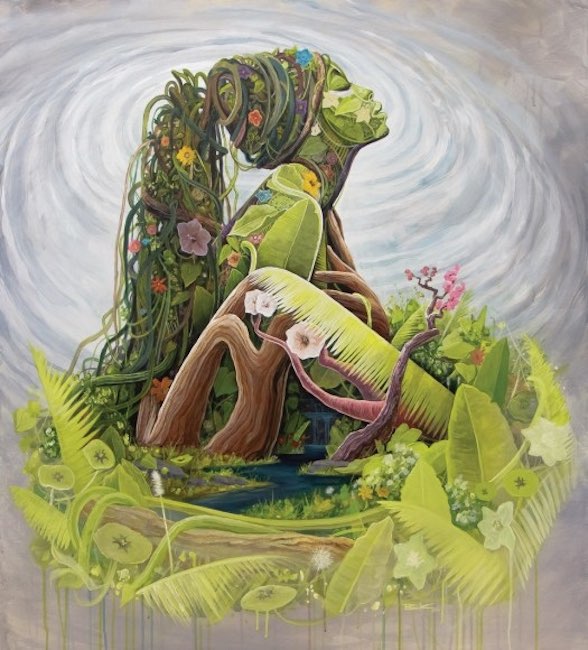
Differentemente da Arcimboldo, le opere di Kirhagis non sono grottesche, in realtà sono incredibilmente armoniose, e sotto la perfezione quasi iperrealista delle figure l’artista nasconde fiori, fili d’erba, rami e foglie che compongo in maniera poetica l’immagine finale; in qualche modo dunque la sua rappresentazione è più vicina alla ricerca estetica di Delvaux sebbene non vi siano più in lui i temi dell’enigma e dell’irrealtà, piuttosto a emergere è un desiderio di contatto profondo con una dimensione, quella naturale, che nella società attuale sembra essere stata messa in disparte dalle illusoriamente luminose e luccicanti città, piene di tutto ma spesso vuote dell’essenza dell’esistenza. Dunque la fuga verso luoghi incontaminati può permettere alle persone di rigenerarsi, di compiere un approfondimento verso ciò che davvero conta, la linfa vitale di un’esistenza troppo frequentemente vissuta in superficie e in cui la priorità è un progresso che va a distruggere un ecosistema che ha permesso proprio alla razza umana di sopravvivere ed evolvere.
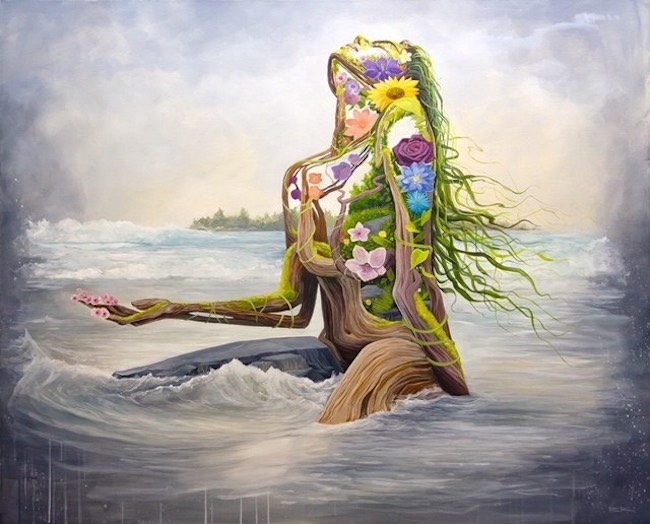
Osservando le tele di Brian Kirhagis non si può non pensare all’Eden, quel paradiso perduto da cui l’uomo è caduto a causa della scelta di una donna, Eva, che con lui diviene messaggera della necessità di provare a ritrovarlo quel sogno di benessere e di tranquillità che le permette di entrare in una nuova armonia con la magia positiva e rigenerante della flora.
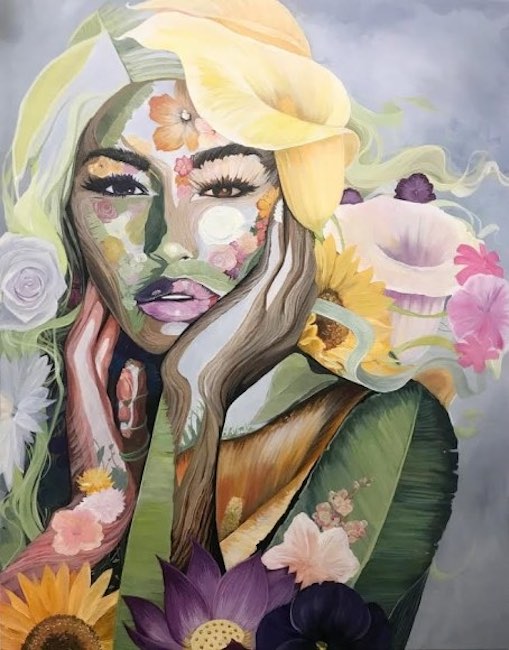
Non solo, la figura della donna è centrale nella produzione dell’artista poiché è proprio quest’ultima con la sua delicatezza, la sensibilità e l’empatia, che può divenire guida per condurre l’umanità verso un domani migliore, privo di aggressività, di competizione, di odio che invece purtroppo ancora contraddistingue i tempi moderni; l’auspicio di Kirhagis è che l’uomo riprenda in mano il suo mondo interiore, quello più puro e ingenuo, e dia vita a un nuovo umanesimo in cui essere più solidale, più rispettoso del pianeta in cui vive, più orientato a vivere intensamente delle piccole cose che in fondo sono le uniche a rendere l’esistenza un’esperienza meravigliosa.
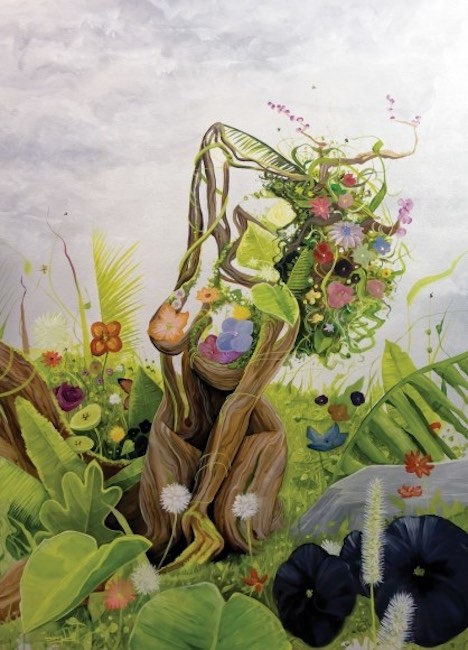
Gli sfondi delle tele sono completamente decontestualizzati, quasi a tendere verso l’astrazione, per mettere in risalto il verde e le tonalità dei fiori, per infondere nell’osservatore quel senso di morbidezza che trasforma le immagini in luoghi sognanti dentro cui desiderare di trovarsi. L’amore per la vita è ciò che emerge dalla serie pittorica Earth, un lasciarsi andare alle sensazioni positive, all’armonica musicalità dell’ascolto della propria essenza, al perdersi dentro quell’alchimia in cui si può avvertire l’eco del muoversi delle foglie, del lento fluire delle acque spesso presenti nelle tele, della sofficità dell’atmosfera; ed è in questo contesto fatato che Brian Kirhagis colloca le sue protagoniste, riflessive, assorte, spesso rapite dalle loro stesse emozioni.
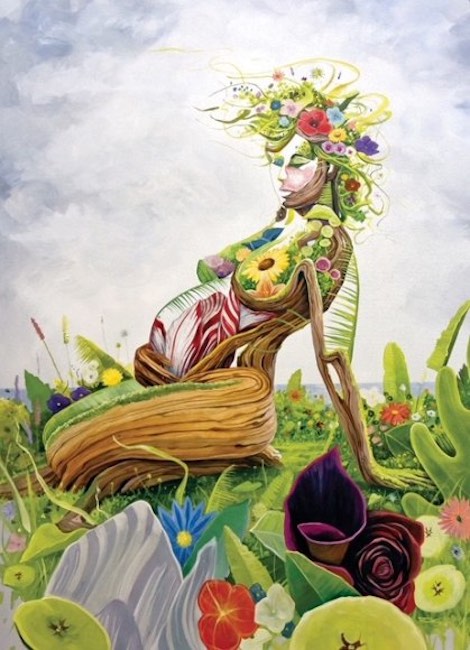
A volte affascinanti e bellissime giovani donne, altre future mamme perché in fondo l’atto della nascita dell’essere umano non è poi tanto distante dal fiorire primaverile inteso come nuova vita dopo il disgelo dall’inverno, altre ancora invece perse dentro un ricordo o una sensazione che non riescono a gestire e per cui chiedono aiuto alla natura che le circonda e le avvolge con la sua delicatezza.
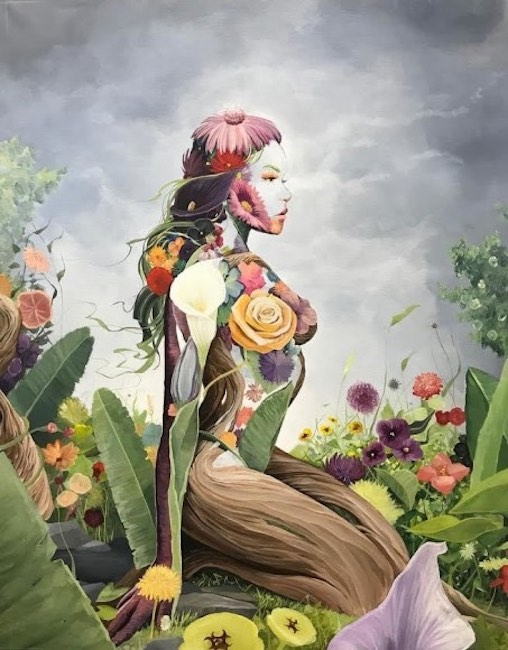
In Earth #22 la ragazza al centro della scena sembra essere perplessa, quasi a domandare a un immaginario punto lontano da sé quale possa essere la scelta migliore, quella con cui dare corpo a un sogno che sembra distante ma mai irraggiungibile; la parte inferiore del corpo, in questa come in tutte le opere di Kirhagis, è costituita da tronchi e rami, a sottolineare l’importanza della solidità, delle radici su cui fondare la propria vita, quei legami familiari che non possono prescindere dall’individuo costituendone la base principale in virtù della quale potersi poi muovere verso le emozioni e i sogni rappresentati, nella parte superiore dei corpi, dai fiori e dalle foglie.
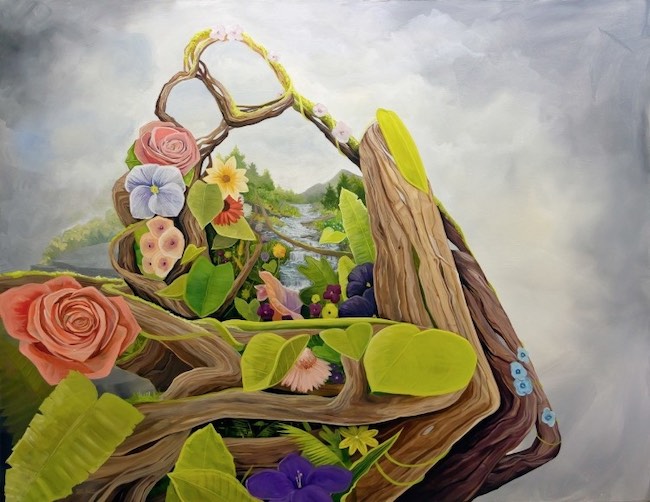
In Earth #6 invece in primo piano è la mano di una mamma che sorregge il piccolo piede di un neonato, figlio di un mondo migliore fatto di armonia, di purezza, di un ritorno alla natura che avrà il potere di rendere la sua vita un percorso meraviglioso. Brian Kirhagis ha alle spalle un percorso professionale di grande rilevanza, perseguito agli inizi con la sola forza di volontà, di fiducia in se stesso e nella consapevolezza di avere un dono, quello dell’essere un artista, che gli avrebbe permesso di far sentire la sua voce; attualmente vanta collezionisti in tutto il mondo oltre ad aver riscosso molti consensi tra la critica internazionale e gli addetti ai lavori.
BRIAN KIRHAGIS-CONTATTI
Sito web: www.bktheartist.com/
Facebook: www.facebook.com/brikart
Instagram: www.instagram.com/bktheartist/
The Surrealism of Brian Kirhagis to highlight the need to rediscover a profound dialogue between human beings and nature
Contemporary living often leads the individual to immerse himself in a utilitarian reality, in which all that seems to take on greater importance is running towards material goals, accumulating wealth, pursuing aims that do not lead to the evolution of interiority but merely give the illusion of being important on the basis of what one can possess; artists in this context appear as a voice out of the chorus because through their unique sensitivity they succeed in highlighting everything that man tends to overlook, distracted by the thousand lights of the ephemeral that is indicated as the only thing that really counts. Therefore, through the images of creative artists, it is possible to rediscover a profound contact that induces the observer to analyse with a different point of view everything that revolves around him and that normally remains ignored. Today’s protagonist puts nature in the foreground, transforming it into the undisputed realm and compositional element of human expressiveness.
The originality of treating the natural theme in an unusual way came to a head in the 17th century with the artistic production of Giuseppe Arcimboldo, the forerunner of Surrealism and interpreter of his own particular vision of Mannerism; his grotesque heads made of vegetables and fruit, which shook the sensibilities of the artistic world of the time, were in fact a philosophical-alchemical investigation into the meaning of reality, the hidden significance and irreverent allegory of certain physical characteristics of the subjects depicted transformed into elements of nature that made them up. Arcimboldo‘s portraits were ignored until the 20th century when the birth of Surrealism allowed artists and scholars to take him as a reference more for the psychological analysis hidden in his artworks; on the other hand, the Surrealist themes, the most shocking and irreverent movement of the 20th century, explored precisely that inner world, anxieties, anguish and above all decontextualisation from the contingent reality, inducing the observer to question what really lurked beyond appearances.
Among the great masters of Surrealism, it was in particular Belgians such as René Magritte and Paul Delvaux, albeit in a different way from the point of view of the subjects represented, to question in a subtle and meditative manner the relationship between man and nature, the secrets hidden behind the objects or landscapes depicted and the metaphors to which certain elements were bound, instilling in the observer a need to delve deeper than the visible in order to connect with all the subtle energies that envelop existence and the environments in which human beings live. It was Delvaux who was perhaps the most incisive in collecting the legacy of Giuseppe Arcimboldo, as in many of his works he gave foliage-like headdresses to his female protagonists, or transformed the lower part of their bodies into tree trunks, thus giving the figures a magical aspect, made even more mystical by the nocturnal and mysterious atmospheres that characterised his paintings. And it was probably from Delvaux and the neoclassical architectural elements, another sign often found in his painting, that the wealthy patron Eward James was inspired when he wanted to build a huge surrealist monument in the middle of the Mexican forest called Las Pozas, also known as the Surrealist Xanadu, an architectural edifice made of stairs leading to nowhere, of lintels supporting the lightness of the sky and the humid air of the forest, which introduces the attitude of Surrealist poetics of maintaining contact with nature and its mysteries.
The American artist Brian Kirhagis takes up the same theme, modifying and adapting it not only to modernity but also to his point of view on reality and on the acute and sensitive observation of everything that belongs to present-day living, so that nature is no longer a treasure chest of mysteries but becomes a mother, a soft environment in which to take refuge and to which to entrust the fears and insecurities that characterise contemporary times. Unlike Arcimboldo, Kirhagis‘ artworks are not grotesque, in fact they are incredibly harmonious, and beneath the almost hyperrealist perfection of the figures the artist conceals flowers, blades of grass, branches and leaves that poetically compose the final image; in some ways, therefore, his representation is closer to Delvaux‘s aesthetic research, although the themes of enigma and unreality are no longer present in him. Rather, what emerges is a desire for profound contact with a dimension, the natural dimension, which in today’s society seems to have been put aside by the illusorily bright and glittering cities, full of everything but often empty of the essence of existence. So the escape to uncontaminated places can allow people to regenerate themselves, to go deeper into what really counts, the lifeblood of an existence too frequently lived on the surface and in which the priority is progress that destroys an ecosystem that has allowed the human race to survive and evolve. Observing Brian Kirhagis‘ canvases, one cannot help but think of Eden, that lost paradise from which man has fallen because of the choice of a woman, Eve, who with him becomes the messenger of the need to try to regain that dream of well-being and tranquillity that allows her to enter into a new harmony with the positive and regenerating magic of flora.
Not only that, the figure of the woman is central to the artist’s production because it is precisely she, with her delicacy, sensitivity and empathy, who can become a guide to lead humanity towards a better tomorrow, free of the aggression, competition and hatred that unfortunately still characterise modern times; Kirhagis‘ hope is that man will take back his inner world, the purest and most ingenuous one, and give life to a new humanism in which he can be more supportive, more respectful of the planet in which he lives, more oriented towards living intensely the little things that, after all, are the only things that make existence a wonderful experience. The backgrounds of the canvases are completely decontextualised, almost tending towards abstraction, in order to emphasise the greenery and the tones of the flowers, to instil in the observer that sense of softness that transforms the images into dreamy places in which one wishes to find oneself. Love for life is what emerges from the Earth series of paintings, a letting go of positive sensations, of the harmonious musicality of listening to one’s own essence, of losing oneself in that alchemy in which one can hear the echo of the movement of the leaves, of the slow flow of the waters often present in the canvases, of the softness of the atmosphere; and it is in this enchanted context that Brian Kirhagis places his protagonists, reflective, absorbed, often enraptured by their own emotions. Sometimes they are charming and beautiful young women, others are mothers-to-be because after all, the act of human birth is not so far from spring blooming understood as new life after the thaw of winter, while others are lost in a memory or a feeling that they cannot manage and for which they ask for help from nature, which surrounds them and envelops them with its delicacy.
In Earth #22 the girl at the centre of the scene seems to be perplexed, almost as if asking an imaginary point far away from herself what the best choice might be, the one with which to give substance to a dream that seems distant but never unattainable; the lower part of the body, in this as in all Kirhagis‘s paintings, is made up of trunks and branches, underlining the importance of solidity, of the roots on which to establish one’s life, those family ties that cannot be separated from the individual, constituting the main ground on the basis of which one can then move towards the emotions and dreams represented, in the upper part of the bodies, by flowers and leaves. In Earth #6, on the other hand, in the foreground is the hand of a mother holding the little foot of a newborn child, the baby of a better world made of harmony, purity, a return to nature that will have the power to make his life a wonderful journey. Brian Kirhagis has behind him a professional career of great significance, pursued at the beginning by sheer force of will, self-confidence and in the knowledge that he has a gift, that of being an artist, which would allow him to make his voice heard; he currently boasts collectors all over the world as well as having received much acclaim from international critics and insiders.














